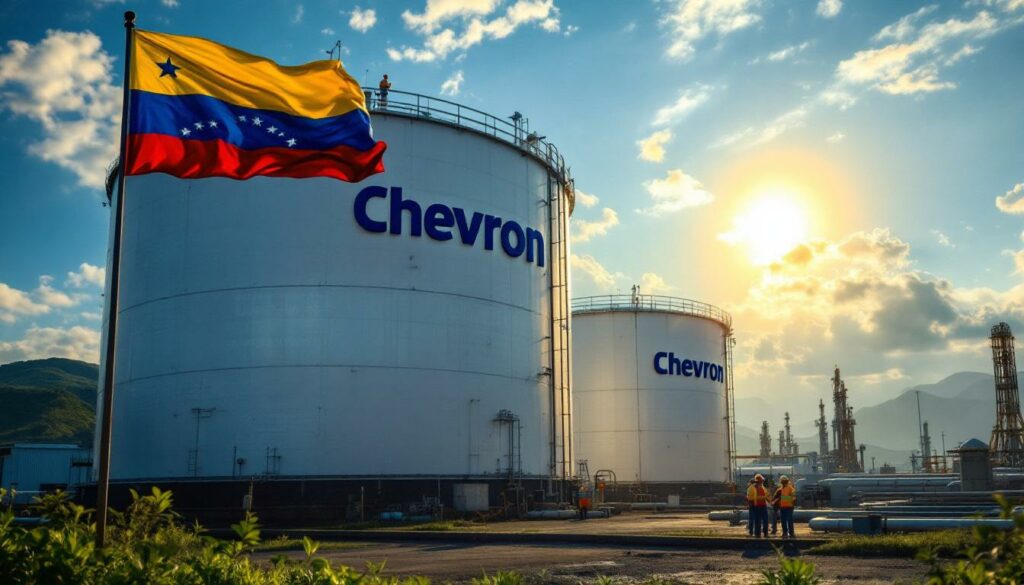Understanding Chevron's Venezuela Strategy
The Historical Context of Chevron in Venezuela
Chevron's presence in Venezuela represents one of the most enduring foreign investments in the country's oil sector, spanning nearly a century. Before the imposition of U.S. sanctions in 2019, the company maintained significant joint ventures with Venezuela's state oil company Petróleos de Venezuela, S.A. (PDVSA), primarily through stakes in the Petropiar and Petroboscan projects. These partnerships gave Chevron strategic access to Venezuela's vast reserves—estimated to be the largest proven oil reserves in the world at approximately 303.8 billion barrels.
The company's historical operations were centered in the resource-rich Orinoco Belt, where the Petropiar facility was designed to process heavy crude into more valuable synthetic crude products. In western Venezuela, the Petroboscan joint venture focused on conventional oil production in the traditional Maracaibo Basin fields. At their peak, these operations contributed significantly to Chevron's global portfolio, with production reaching approximately 200,000 barrels per day before sanctions.
"Chevron's century-long presence in Venezuela represents not just a business investment, but a remarkable case study in navigating the complex geopolitics of Latin American oil development through multiple regime changes and economic cycles." — Energy historian Daniel Yergin
The Impact of U.S. Sanctions on Operations
The implementation of comprehensive U.S. sanctions against Venezuela's oil sector in January 2019 created an unprecedented operational challenge for Chevron. Unlike European and Asian competitors who withdrew entirely, Chevron secured special limited licenses from the U.S. Treasury Department's Office of Foreign Assets Control (OFAC) that permitted only basic maintenance activities—effectively creating a "preserve and protect" mandate for its Venezuelan assets.
During this period of restricted operations (2019-2024), Chevron:
- Maintained skeleton crews at key facilities to prevent deterioration
- Conducted essential safety and environmental monitoring
- Performed limited well maintenance to prevent permanent damage
- Preserved documentation and intellectual property
- Retained key local talent through minimal but critical operations
The sanctions effectively reduced Chevron's operational footprint to less than 10% of pre-2019 levels while prohibiting any revenue generation or production activities. This created a unique corporate limbo—maintaining a presence without the ability to extract economic value from billions in investments.
What Changed in U.S. Policy Toward Venezuela?
The Evolution of Sanctions Relief
The shift in U.S. policy toward Venezuela's oil sector represents a carefully calibrated diplomatic recalibration rather than a complete reversal. Beginning in late 2024, the Treasury Department's OFAC began issuing specialized licenses to Chevron allowing for the phased resumption of limited production activities under strict conditions. This policy evolution reflects what analysts have termed "sanctions with offramps"—maintaining the broader sanctions architecture while creating specific carve-outs tied to diplomatic and governance objectives.
The licenses issued to Chevron include several critical provisions:
- Permission to restart production at specific joint ventures (primarily Petropiar and Petroboscan)
- Authorization to conduct necessary repairs and infrastructure rehabilitation
- Ability to import required equipment and materials otherwise restricted by sanctions
- Limited rights to market and sell resulting oil production
- Strict prohibitions on any transactions with specifically sanctioned Venezuelan officials
These targeted exemptions represent what Treasury officials have called a "narrow pathway" designed to test Venezuela's willingness to implement reforms while addressing global energy security concerns.
Geopolitical Factors Driving Policy Changes
The recalibration of U.S. policy toward Venezuela's oil sector reflects a complex matrix of geopolitical considerations extending far beyond bilateral relations. Four primary factors have converged to create this policy shift:
Global energy security imperatives: The disruption of Russian heavy crude supplies following Ukraine-related sanctions created critical supply gaps for specialized Gulf Coast refineries designed specifically for processing heavy, high-sulfur crude—precisely the type Venezuela produces. As one energy analyst noted, "Venezuelan crude isn't just an alternative—it's an ideal substitute with nearly identical specifications for certain U.S. refining infrastructure."
Strategic competition with China and Russia: During the sanctions period, Chinese and Russian companies significantly expanded their footprint in Venezuela's oil sector. CNPC (China) and Rosneft (Russia) secured preferential access to development blocks and financial arrangements, increasing their influence in a country holding the world's largest proven reserves. The gradual reintroduction of Western companies serves as a counterbalance to this expanding influence.
Regional migration management: The economic collapse in Venezuela has driven one of the largest migration crises in recent history, with over 7.1 million Venezuelans leaving the country and creating significant pressures on neighboring nations. Enabling limited economic recovery through the oil sector represents one mechanism for potentially stabilizing this population movement.
Democratic governance incentives: The licenses contain specific provisions allowing for revocation if Venezuela fails to meet certain governance benchmarks, creating what diplomats term "reversible incentives" for political reforms. This approach reflects a shift from blanket sanctions toward more targeted economic diplomacy.
"The Venezuela policy shift represents the most significant test case of the Biden administration's theory that sanctions are most effective when they include clearly defined paths to relief tied to specific policy objectives." — Foreign policy analyst Richard Haass
How Is Chevron Structuring Its Return?
Current Operational Framework
Chevron's reentry into operational activities in Venezuela is proceeding under a tightly controlled framework designed to navigate the complex requirements of partially lifted sanctions. The company has established a segregated corporate structure specifically for its Venezuelan operations, creating what compliance experts call a "sanctions firewall" between these activities and its broader global operations.
This operational architecture includes:
- Creation of a specialized compliance team with direct reporting lines to U.S. authorities
- Establishment of separate financial channels that prevent commingling with sanctioned entities
- Implementation of enhanced transaction monitoring systems with third-party verification
- Development of "pre-clearance" protocols for all significant operational decisions
- Regular auditing by independent monitors approved by U.S. regulators
The framework also incorporates strict limitations on the types of activities permitted. Chevron may rehabilitate existing wells and infrastructure but faces restrictions on certain types of new drilling activities. Financial transactions must follow prescribed pathways that prevent benefits from flowing to specifically sanctioned individuals or entities within the Venezuelan government.
Production Restart Strategy
Chevron has implemented a methodical, phased approach to resuming operations that prioritizes rapid production from existing assets while minimizing technical and compliance risks. This strategy includes five distinct phases:
Phase 1: Technical Assessment and Safety Remediation (Months 1-3)
- Comprehensive inspection of all field equipment and infrastructure
- Rehabilitation of critical safety and environmental monitoring systems
- Reestablishment of baseline production metrics and integrity testing
- Assembly and deployment of technical teams to field locations
Phase 2: Existing Well Rehabilitation (Months 3-6)
- Workover operations on shut-in wells with highest potential production rates
- Repair of gathering systems and flow lines to existing processing facilities
- Implementation of enhanced production monitoring technologies
- Restoration of essential power and utility systems
Phase 3: Processing Facility Optimization (Months 6-9)
- Rehabilitation of key processing units at Petropiar and Petroboscan facilities
- Calibration of quality control systems to meet export specifications
- Implementation of emissions monitoring and control systems
- Restoration of storage and transportation infrastructure
Phase 4: Production Stabilization (Months 9-12)
- Gradual increase in production rates as infrastructure permits
- Implementation of water and gas handling capacity improvements
- Optimization of artificial lift systems in mature fields
- Integration of digital monitoring systems for compliance verification
Phase 5: Selective Growth Activities (Beyond Month 12)
- Targeted drilling in existing fields based on license provisions
- Incremental expansion of processing capacity at key facilities
- Enhancement of export infrastructure capabilities
- Development of medium-term production growth roadmap
This phased approach reflects what petroleum engineers call "the reverse decline curve strategy"—focusing first on the most readily recoverable production before moving to more complex rehabilitation activities.
What Are the Economic Implications?
Potential Production Volumes
Industry analysts have developed production forecasts for Chevron's Venezuela operations based on technical assessments of field conditions and infrastructure status. These projections reflect the challenging starting point after years of operational neglect but also recognize the significant recovery potential in Venezuela's prolific heavy oil fields:
Short-Term Production Targets (0-12 months):
- Initial production: 30,000-50,000 barrels per day (first 3 months)
- Ramp-up phase: 50,000-100,000 barrels per day (months 3-9)
- Stabilization phase: 100,000-150,000 barrels per day (months 9-12)
Medium-Term Potential (12-36 months):
- Base case: 150,000-200,000 barrels per day
- Optimistic case: 200,000-250,000 barrels per day (contingent on additional sanctions relief)
- Constrained case: 100,000-150,000 barrels per day (if technical challenges prove more severe)
Long-Term Capability (Beyond 36 months):
- Technical potential: 400,000-500,000 barrels per day
- Realistic projection accounting for constraints: 300,000-350,000 barrels per day
- Minimum sustainable economic threshold: 150,000 barrels per day
These projections are heavily dependent on several key variables, including:
- The condition of subsurface reservoirs after prolonged shut-in periods
- The degree of infrastructure deterioration beyond visible assessment
- The availability of specialized equipment and technical services
- The stability of the regulatory and operating environment
- The evolution of the sanctions framework over time
As one petroleum engineer with experience in Venezuela noted, "The productive capacity exists, but the path to reaching it is more complex than in conventional recovery situations due to the years of deferred maintenance and investment."
Financial Arrangements and Debt Recovery
The financial framework governing Chevron comeback in Venezuela represents an innovative approach to operating in a partially sanctioned environment while addressing legacy debt issues. The company is navigating the complex challenge of recovering approximately $3.4 billion in outstanding receivables from PDVSA while complying with sanctions that restrict certain types of financial transactions.
The core elements of this financial structure include:
Debt Recovery Mechanisms:
- Commodity-backed loan repayments using portion of production
- Prioritized access to export volumes to service outstanding debt
- Conversion of certain debt instruments to equity in joint ventures
- Discounted settlement options for immediate cash recovery
- Staged repayment schedules tied to production thresholds
Revenue Management System:
- Segregated accounts for operational expenses versus profit distributions
- Third-party verification of all financial flows
- Transparent reporting mechanisms to U.S. regulators
- Escrow structures for certain categories of payments
- Pre-approved payment pathways for vendors and contractors
Investment Recovery Provisions:
- Production-sharing modifications weighted toward initial recovery periods
- Accelerated depreciation allowances for new capital expenditures
- Tax stabilization provisions to ensure predictable fiscal terms
- Special provisions for extraordinary rehabilitation expenditures
- Performance-based incentives tied to production milestones
This framework represents what financial analysts describe as a "sanctions-compliant value recovery model" designed to balance immediate cash flow needs with longer-term value creation while maintaining strict adherence to remaining sanctions provisions.
What Challenges Does Chevron Face in Venezuela?
Infrastructure and Technical Hurdles
The technical challenges facing Chevron's return to Venezuela extend far beyond normal operational issues, reflecting years of underinvestment and deterioration across the entire hydrocarbon value chain. Field assessments have revealed multiple critical issues requiring immediate attention:
Well Integrity Concerns:
- Extensive corrosion in wellhead equipment and downhole tubulars
- Compromised cementing in many wells creating potential safety hazards
- Sand control failures in numerous heavy oil wells
- Scale and asphaltene buildup restricting production pathways
- Electrical submersible pump failures in artificial lift systems
Surface Facility Deterioration:
- Widespread corrosion in processing equipment and piping systems
- Instrumentation and control system obsolescence and failures
- Power generation capacity deficits exceeding 60% of requirements
- Cooling water and utility system degradation
- Safety systems requiring comprehensive recertification
Logistical and Supply Chain Constraints:
- Critical spare parts shortages for specialized equipment
- Limited availability of drilling rigs meeting technical specifications
- Deteriorated road and transportation infrastructure
- Compromised port facilities for equipment imports
- Limited technical service provider presence in country
These challenges are compounded by what petroleum engineers term the "knowledge gap" created by the exodus of skilled technical personnel during Venezuela's economic crisis. An estimated 70% of experienced oil field professionals left the country between 2014-2023, creating significant human resource constraints.
Political and Regulatory Uncertainties
Beyond technical challenges, Chevron faces a complex and evolving political and regulatory landscape that creates significant operational uncertainties. These political factors extend from local community dynamics to national governance issues:
Governance and Regulatory Framework:
- Evolving legal structures governing foreign investment in the oil sector
- Uncertain application of existing regulations after years of limited enforcement
- Overlapping and sometimes contradictory authorities between agencies
- Capacity limitations within regulatory bodies after institutional deterioration
- Vulnerability to policy shifts based on political developments
Security Considerations:
- Varying security conditions across different operating regions
- Supply chain vulnerabilities to disruption or diversion
- Physical infrastructure protection requirements
- Cybersecurity concerns for operational technology systems
- Personnel safety protocols in remote operating areas
Labor Relations Dynamics:
- Workforce skill gaps requiring extensive training programs
- Complex relations with union structures after prolonged operational hiatus
- Wage and benefit expectations in a distorted economic environment
- Productivity challenges after years of limited operational activity
- Recruitment competition for limited technical talent pool
Local Community Expectations:
- Heightened expectations for economic benefits after prolonged downturn
- Infrastructure needs in communities surrounding operations
- Environmental remediation requirements for legacy issues
- Social investment expectations beyond normal corporate responsibility
- Stakeholder communication challenges in polarized political environment
These political and regulatory uncertainties create what risk analysts describe as "compound risk factors" that must be managed simultaneously rather than sequentially, requiring sophisticated government relations and community engagement strategies.
How Does This Affect Global Oil Markets?
Impact on Global Supply and Prices
The reintroduction of Venezuelan heavy crude into global markets through Chevron's operations represents a significant development for specific market segments rather than a transformative change to overall global supply balances. The impact is particularly pronounced in three specialized market niches:
U.S. Gulf Coast Refining Complex:
- Increased availability of heavy, high-sulfur crude ideally suited for complex coking refineries
- Partial offset for reduced Russian Urals crude availability at these facilities
- Improved refining margins for facilities designed specifically for Venezuelan-type crude
- Reduced transportation costs compared to alternative heavy crude sources
- Enhanced supply security through geographic proximity
Global Heavy Crude Differentials:
- Moderate narrowing of heavy/light crude price differentials in Western Hemisphere markets
- Competitive pressure on Canadian heavy crude pricing into U.S. Gulf Coast
- Limited impact on Maya crude (Mexico) pricing into similar markets
- Potential rebalancing of heavy crude trade flows between Atlantic and Pacific basins
- Gradual normalization of distorted heavy crude premium created by supply constraints
Refined Product Implications:
- Improved economics for high-sulfur fuel oil production
- Enhanced availability of petroleum coke for industrial applications
- Marginally improved diesel production economics at complex refineries
- Limited direct impact on gasoline markets
- Potential slight improvement in asphalt availability for infrastructure projects
The market impact is characterized by what commodity analysts call "segmented significance"—substantial importance for specific market niches without creating major shifts in broader global oil pricing. As one refining expert noted, "Venezuelan crude's return primarily solves a quality problem rather than a quantity problem in global markets."
Strategic Positioning Against Competitors
Chevron's early reentry into Venezuela creates significant strategic advantages relative to both Western competitors and state-owned companies from China and Russia that expanded their presence during the sanctions period. This positioning includes both immediate operational benefits and long-term strategic optionality:
Competitive Advantages Over Western Competitors:
- First-mover benefits in accessing prime operational assets
- Established relationships with key technical personnel and suppliers
- Comprehensive technical understanding of reservoir conditions
- Existing infrastructure footprint for rapid production restart
- Regulatory pathways already established through license process
Strategic Positioning Against National Oil Companies:
- Access to premium heavy crude varieties particularly suited for U.S. refineries
- Transportation and logistics advantages for Western Hemisphere markets
- Established compliance frameworks addressing sanctions concerns
- Technical capabilities specifically developed for Venezuela's challenging reservoirs
- Long-standing community and stakeholder relationships
Long-Term Strategic Optionality:
- Positioned for expanded opportunities if OPEC global influence continues to evolve
- Potential preferential access to new development areas
- Ability to leverage existing infrastructure for growth options
- Relationships with service companies for priority access to equipment
- Knowledge base for evaluating additional investment opportunities
This strategic positioning reflects what industry analysts call "the incumbent advantage"—the ability to leverage existing knowledge, relationships and infrastructure to create barriers to entry for potential competitors considering market entry as conditions improve.
What Are the Environmental and Social Considerations?
Environmental Management Challenges
The environmental dimensions of Chevron's return to Venezuela present some of the most complex operational challenges, reflecting both legacy issues from years of underinvestment and the sensitive ecological settings of many production areas. These challenges span multiple environmental domains:
Legacy Contamination Issues:
- Produced water management systems operating below design specifications
Looking to Invest in the Next Big Mineral Discovery?
Discover significant ASX mineral discoveries in real-time with Discovery Alert's proprietary Discovery IQ model, which turns complex data into actionable insights for immediate trading opportunities. Explore why major mineral discoveries can lead to substantial market returns by visiting Discovery Alert's dedicated discoveries page, and begin your 30-day free trial today to position yourself ahead of the market.




